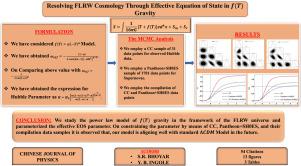Resolving FLRW cosmology through effective equation of state in f(T) gravity
IF 4.6
2区 物理与天体物理
Q1 PHYSICS, MULTIDISCIPLINARY
引用次数: 0
Abstract
This article explores the cosmological scenario of the universe in the context of the power law model, where represents the torsion scalar. To obtain the deterministic solution of the field equations, we parameterized the effective equation-of-state (EoS) with two parameters and as suggested by A. Mukherjee in a flat FLRW environment. We impose constraints on the free parameters of the derived solution by utilizing MCMC analysis, assuming the , and as data samples. We explore the dynamics of cosmological parameters. The evolutionary profile of the deceleration parameter exhibits the transition to the accelerated phase. The effective EoS parameter indicates that the model remains in the quintessence era and gradually becomes the Einstein–de Sitter model. In addition, we explore the jerk, snap, and lerk parameters. Furthermore, the diagnostic shows that the model has a consistent positive slope across the entire evolution, but soon resembles the standard CDM model. Finally, we conclude that the power law model of the gravity in the framework of the FLRW universe aligns more closely with the CDM model for given observational data.

通过 f(T) 引力中的有效状态方程解析 FLRW 宇宙学
本文在 f(T) 幂律模型(其中 T 代表扭转标量)的背景下探讨了宇宙学情景。为了得到场方程的确定性解,我们按照 A. Mukherjee 的建议,在平坦 FLRW 环境中用两个参数 m 和 k 对有效状态方程(EoS)进行了参数化。我们利用 MCMC 分析,假定 CC、Pantheon+SH0ES 和 CC+Pantheon+SH0ES 为数据样本,对导出解的自由参数施加约束。我们探索了宇宙学参数的动态变化。减速参数的演化曲线显示了向加速阶段的过渡。有效 EoS 参数表明该模型仍处于五元时代,并逐渐成为爱因斯坦-德-西特模型。此外,我们还探究了跃迁(jerk)、骤变(snap)和钝化(lerk)参数。此外,Om(z) 诊断显示,该模型在整个演化过程中具有一致的正斜率,但很快就类似于标准的ΛCDM 模型。最后,我们得出结论,在 FLRW 宇宙框架下,f(T) 引力的幂律模型与给定观测数据下的 ΛCDM 模型更为接近。
本文章由计算机程序翻译,如有差异,请以英文原文为准。
求助全文
约1分钟内获得全文
求助全文
来源期刊

Chinese Journal of Physics
物理-物理:综合
CiteScore
8.50
自引率
10.00%
发文量
361
审稿时长
44 days
期刊介绍:
The Chinese Journal of Physics publishes important advances in various branches in physics, including statistical and biophysical physics, condensed matter physics, atomic/molecular physics, optics, particle physics and nuclear physics.
The editors welcome manuscripts on:
-General Physics: Statistical and Quantum Mechanics, etc.-
Gravitation and Astrophysics-
Elementary Particles and Fields-
Nuclear Physics-
Atomic, Molecular, and Optical Physics-
Quantum Information and Quantum Computation-
Fluid Dynamics, Nonlinear Dynamics, Chaos, and Complex Networks-
Plasma and Beam Physics-
Condensed Matter: Structure, etc.-
Condensed Matter: Electronic Properties, etc.-
Polymer, Soft Matter, Biological, and Interdisciplinary Physics.
CJP publishes regular research papers, feature articles and review papers.
 求助内容:
求助内容: 应助结果提醒方式:
应助结果提醒方式:


